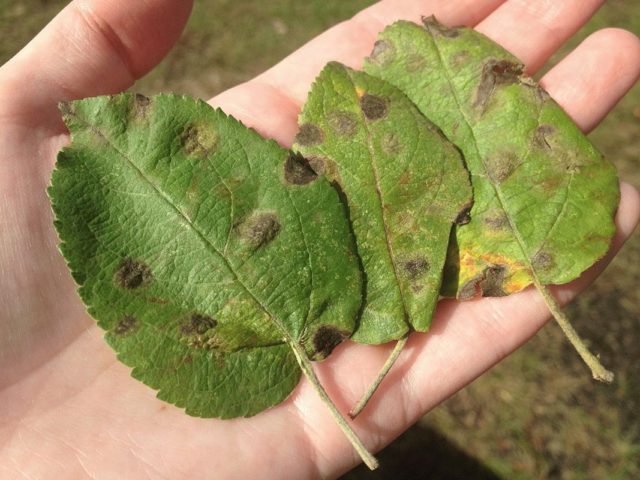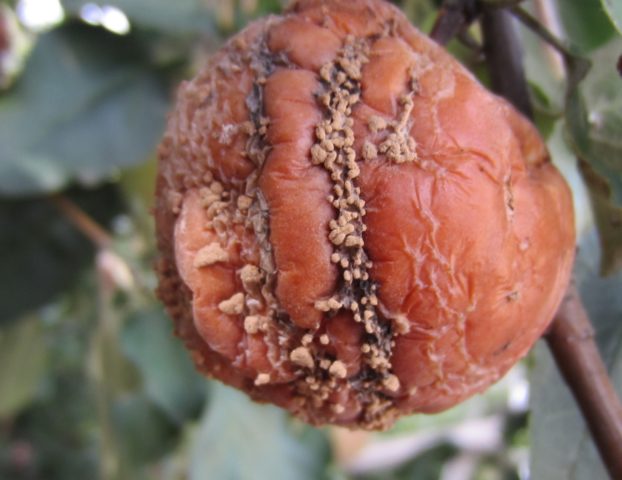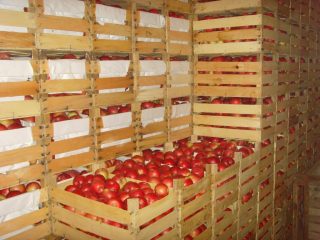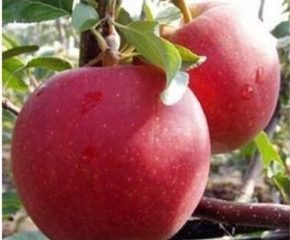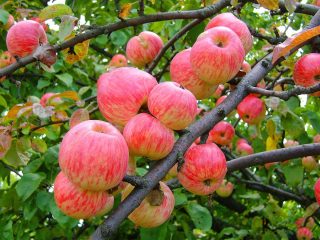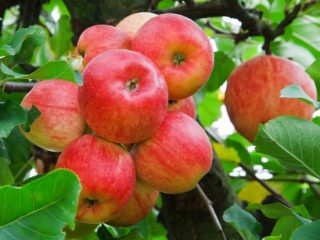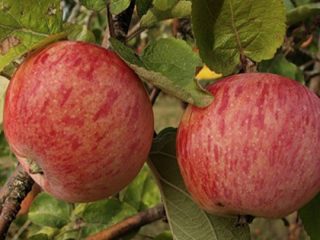Content
Column-shaped apple tree The Moscow necklace differs from other fruit trees in appearance. However, the narrow crown, along with the absence of long side branches, is not an obstacle for the variety's good yields.
Breeding history (first name X-2)
The columnar apple tree Moscow Necklace (another name is X-2) was bred by the Russian breeder Mikhail Vitalievich Kachalkin on the basis of American and Canadian varieties, in particular, Macintosh. At first, the scientist named the new variety simply “X-2”, but later replaced it with a more beautiful “Moscow necklace”.

A small crown of an apple tree Moscow necklace is not an obstacle to a good harvest
Characteristics of the columnar apple Moscow necklace
The Moscow necklace is a semi-dwarf fruit crop that does not require a lot of space to grow. However, despite its modest size, the tree not only becomes an adornment of the suburban area, but also gives a good harvest of sweet and juicy apples.
Fruit and tree appearance
Apple tree The Moscow necklace looks like a column (hence the name "columnar"), strewn with a large number of apples. The height of an annual seedling is 80 cm, while an adult tree grows up to 2-3 m.
The trunk of the tree is not very thick, but strong, which allows it to withstand a bountiful harvest of fruits. The bark is brown.
Crown of apple tree columnar Moscow necklace narrow, straight, compact. Skeletal branches are short, covered with brown bark. Young shoots are green. The lateral ones are located vertically, which provides the fruit with good access to sunlight.
The leaves are dark green in shape, resembling an ellipse with a pointed top.
The apples are large, spherical. The average weight of one fruit is 200 g. The peel is thin, glossy, in the stage of full ripeness it has a rich red hue. The pulp is fine-grained, dense, creamy yellow in color.

Columnar crops can be a garden decoration
Life span
The tree can live up to 20-25 years. However, due to the end of the fruiting period after 15 years, it is impractical to grow this apple tree in a garden plot.
Taste
Moscow necklace is a dessert variety. The apples are juicy, sweet and sour, with a delicate fruity aroma.
Growing regions
The crop is suitable for growing in different climatic areas. However, this variety is more popular in the regions of central Russia and in southern Siberia.
Yield
The columnar apple-tree Moscow necklace bears fruit annually. The yield of the variety is assessed as high, its peak falls on 4-6 years of life. The annual harvest of such a tree is about 10 kg of apples.
Stable fruiting usually lasts until the age of twelve, then the yield decreases. After the 15th year of life, the tree almost completely stops bearing fruit.
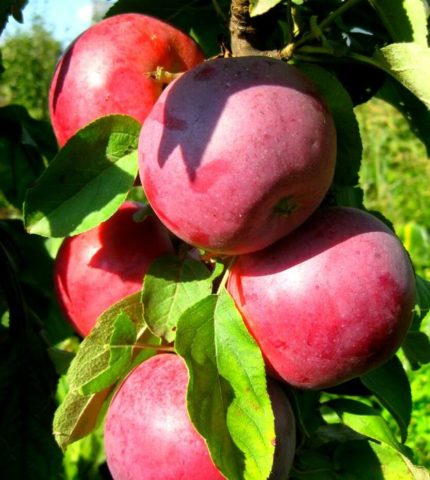
The first fruits appear next fall.
Frost resistant
The columnar apple tree Moscow Necklace is characterized as a frost-resistant variety. In areas with snowy winters, mature trees can normally tolerate temperatures as low as -45 ° C. But for the winter, it is better to cover young seedlings with thick cardboard, agrotextile or spruce branches. This will help protect them from freezing winds and hare raids.
Disease and pest resistance
With proper care, this variety is resistant to fungal diseases. However, excessive humidity and non-compliance with growing recommendations can cause the following problems:
- Brown spotting. The cause of the disease is a fungus that lives in the upper layers of the soil. The presence of the disease can be determined by brown and yellow spots on the surface of the leaves. In the course of treatment, the affected leaves are removed, after which the crown is treated with fungicides.
Yellow and brown spots appear on the leaves with brown spot
- Fruit rot. The first sign of the disease is brown spots on the surface of the fruit. After a while, the apples are deformed and completely rotted. In the course of treatment, the affected fruits are plucked, and the tree is treated with fungicidal preparations.
Rotten fruits pluck
- Caterpillar moth. During the flowering period, the moth caterpillar butterfly leaves eggs on the leaves, from which small larvae then appear. Caterpillars destroy ovaries and penetrate formed fruits, making them unfit for consumption and storage. Insecticides are used to destroy the moth.
The fruit moth gets inside the apple
Flowering period
The blooming of the columnar apple tree Moscow necklace begins in late spring. Young trees can bloom in the first spring of their life, covered with beautiful, white-pink flowers.
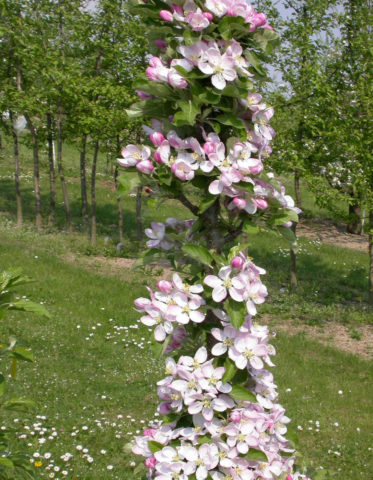
The columnar apple tree blooms in the first spring
When the columnar apple tree ripens Moscow necklace
The first fruits ripen in the second autumn. True, this harvest is never big. Only 6-7 apples ripen on the tree. Harvested in October.
Pollinators of the columnar apple Moscow necklace
Column-shaped apple tree Moscow necklace is a self-fertile variety. Therefore, for cross-pollination and the formation of an ovary, other apple trees must grow in the immediate vicinity of the tree, the flowering period of which coincides with the Moscow necklace. Columnar Vasyugan or President may be suitable pollinators.
Transportation and keeping quality
Apples are notable for good keeping quality; subject to the conditions, they retain their decorative and taste qualities for 2-3 months. Before transportation, it is recommended to put the fruits in boxes, sprinkled with wood shavings or cut paper.
Advantages and disadvantages of the apple variety Moscow necklace
The compact columnar apple tree Moscow necklace X-2 attracts attention with its decorative effect. However, this is not the only positive quality of the variety.
Advantages:
- beautiful view and compactness of culture;
- good fruit taste;
- unpretentiousness and easy care;
- good frost resistance;
- resistance to diseases and pests;
- normal keeping quality of apples and the possibility of their transportation.
Disadvantages:
- relatively short fruiting period.
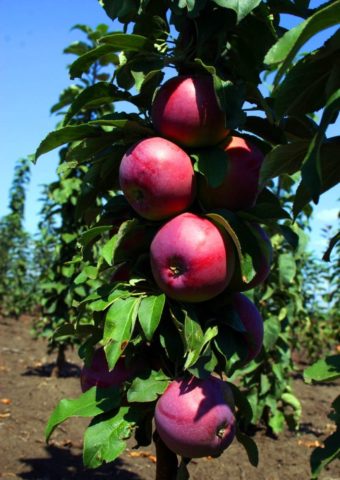
The list of advantages includes decorativeness and compactness of a columnar culture
Planting an apple tree Moscow necklace
Planting material for the columnar apple tree Moscow necklace should be purchased from a nursery or a specialized store. It is better to choose annual shoots; they should have a smooth trunk, viable roots and full-fledged foliage.
The tendency of a variety to bloom in the first year can weaken spring seedlings. Therefore, it is better to plant the Moscow necklace in late September or early November. In this case, the seedling will have time to take root well before the cold weather arrives, so that it will please with the first fruits next autumn.
The site chosen for the columnar apple tree should be well lit by the sun, but at the same time be protected from drafts and cold winds. The tree does not tolerate excess moisture, therefore, a site with a close occurrence of groundwater is not suitable for growing it.
The soil should be breathable, fertile with neutral acidity. Ideally, choose areas with black soil, loamy or sandy loam soil.
During planting:
- dig a hole about 80 cm deep and wide;
- a fertile mixture is made from the top layer of the soil, combining it with humus, compost and mineral fertilizers;
- drainage (pebbles or broken brick) is placed on the bottom of the pit, after which the prepared soil mixture is poured;
- place the seedling in the middle of the hole, gently spreading its roots;
- fill the hole with the remaining soil;
- the ground in the root zone is lightly tamped and an earthen roller is formed for irrigation;
- tie the seedling to a support - a peg, which is driven in next to the trunk;
- the seedling is watered with two buckets of water, after which the soil in the root zone is mulched.
If you plan to plant several trees, they are placed in rows, the gap between which is 1.5 m.The seedlings are placed at a distance of 50 cm.
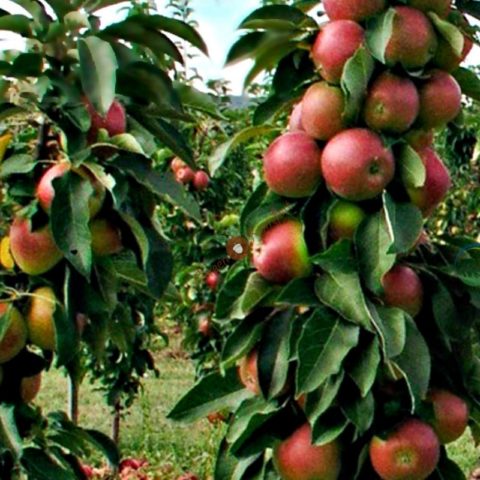
Apple trees are placed at a distance of 50 cm
Growing and care
The rules for caring for a columnar apple tree Moscow necklace are not particularly difficult.
Young seedlings require regular watering as the soil dries out. During the dry season, it is recommended to shower the apple trees twice a month.
In order to increase yields, as well as improve the quality of the fruits, the columnar apple tree Moscow Necklace is systematically fed:
- in the second spring, in the process of loosening the soil, urea is introduced into the root zone;
- before the beginning of the flowering period, the seedlings are fed with rotted cow dung diluted in water;
- after the end of the flowering period, wood ash is introduced into the root zone;
- before wintering, the soil in the root zone is fertilized with humus.
The Moscow necklace variety almost does not need pruning. Only deformed and dry branches are cut off.

Water the apple tree as needed
Collection and storage
Apples reach full ripeness in October. Given the tendency to crack, apples intended for further storage or transportation should be harvested by hand and carefully placed in wooden or plastic containers. In the dark cool month, the fruits do not lose their taste and decorative qualities for 2 months.
Warning! Before storing apples, they should be sorted out, removing damaged and rotten ones.
Conclusion
The columnar apple-tree Moscow necklace is a late-ripening variety that gives a stable yield with minimal maintenance. And the compact shape of the trees allows them to be grown in small areas.
